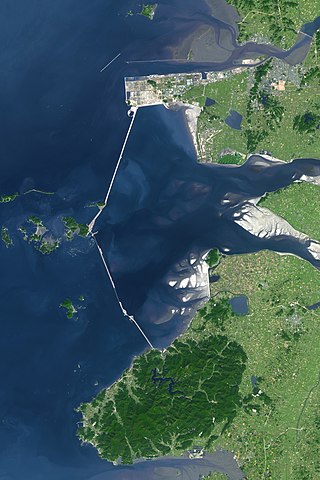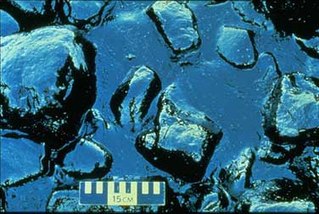
The organized environmental movement is represented by a wide range of non-governmental organizations or NGOs that seek to address environmental issues in the United States. They operate on local, national, and international scales. Environmental NGOs vary widely in political views and in the ways they seek to influence the environmental policy of the United States and other governments.

The Yellow Sea, also known as North Sea, is a marginal sea of the Western Pacific Ocean located between mainland China and the Korean Peninsula, and can be considered the northwestern part of the East China Sea. It is one of four seas named after common colour terms, and its name is descriptive of the golden-yellow color of the silt-ridden water discharged from major rivers.

Trade justice is a campaign by non-governmental organisations, plus efforts by other actors, to change the rules and practices of world trade in order to promote fairness. These organizations include consumer groups, trade unions, faith groups, aid agencies and environmental groups.

Environmental racism, ecological racism, or ecological apartheid is a form of racism leading to negative environmental outcomes such as landfills, incinerators, and hazardous waste disposal disproportionately impacting communities of color, violating substantive equality. Internationally, it is also associated with extractivism, which places the environmental burdens of mining, oil extraction, and industrial agriculture upon indigenous peoples and poorer nations largely inhabited by people of color.
Environmental justice or eco-justice, is a social movement to address environmental injustice, which occurs when poor or marginalized communities are harmed by hazardous waste, resource extraction, and other land uses from which they do not benefit. The movement has generated hundreds of studies showing that exposure to environmental harm is inequitably distributed.

The Ministry of Environment is the South Korea branch of government charged with environmental protection. In addition to enforcing regulations and sponsoring ecological research, the Ministry manages the national parks of South Korea. Its headquarters is in Sejong City.

The Saemangeum Seawall, on the south-west coast of the Korean peninsula, is the world's longest man-made dyke, measuring 33 kilometres (21 mi). It runs between two headlands, and separates the Yellow Sea and the former Saemangeum estuary.
The Korea Federation for Environmental Movements (KFEM) is a non-profit organization in South Korea that focuses on environmentalism.

As with many countries, pollution in the United States is a concern for environmental organizations, government agencies and individuals.

The Kalpasar Project or the Gulf of Khambhat Development Project envisages building a 30 km dam across the Gulf of Khambat in India for establishing a huge fresh water coastal reservoir for irrigation, drinking and industrial purposes. The project with 30 km sea dam will have the capacity to store 10 billion cubic meters fresh water, equating to 25% of Gujarat’s average annual rainwater flow, from the rivers like Narmada, Mahi, Dhadhar, Sabarmati, Limbdi-Bhagovo, and two other minor rivers. A 10 lane road link will also be set up over the dam, greatly reducing the distance between Saurashtra and South Gujarat. The project, which will create world's largest freshwater lake in marine environment, will cost INR90,000 crore or US$12.75 billion excluding the cost of tidal power plant. Project entails construction of the main "Kalpasar dam" across Gulf of Khambat and another Bhadbhut barrage on Narmada river, as well as a canal connecting the two.

Environmental issues are disruptions in the usual function of ecosystems. Further, these issues can be caused by humans or they can be natural. These issues are considered serious when the ecosystem cannot recover in the present situation, and catastrophic if the ecosystem is projected to certainly collapse.

Egypt's environmental problems include, but are not limited to, water scarcity, air pollution, damage to historic monuments, animal welfare issues and deficiencies in its waste management system.

Environmental issues in Russia include pollution and erosion, and have impacts on people, wildlife and ecosystems.
This is a list of notable events relating to the environment in 2006. They relate to environmental law, conservation, environmentalism and environmental issues.
The Environmental Health Coalition (EHC) is an organization founded in 1980 by Diane Takvorian and Tony Pettina, and includes a staff of 19 other individuals. Its goal is to achieve environmental and social justice in San Diego, California. Its work mainly concerns low income communities and communities of color in San Diego. It also works to affect public policy both locally and nationally. The coalition believes that by working closely with communities, it will be able to help mitigate the excessive amounts of pollution and other environmental hazards such as hazardous air pollution (HAPs), toxic waste disposal facilities, or superfund sites. One of its main goals is to prevent environmental injustice in San Diego and use that work to influence national environmental justice issues. Its mission statement is as follows:

Dorceta E. Taylor is an American environmental sociologist known for her work on both environmental justice and racism in the environmental movement. She is the senior associate dean of diversity, equity, and inclusion at Yale School of the Environment, as well as a professor of environmental justice. Prior to this, she was the director of diversity, equity, and inclusion at the University of Michigan's School of Environment and Sustainability (SEAS), where she also served as the James E. Crowfoot Collegiate Professor of Environmental Justice. Taylor's research has ranged over environmental history, environmental justice, environmental policy, leisure and recreation, gender and development, urban affairs, race relations, collective action and social movements, green jobs, diversity in the environmental field, food insecurity, and urban agriculture.
Communities for a Better Environment (CBE), previously known as Citizens for a Better Environment, is a policy-focused non-profit organization started in 1971 by Marc Anderson and David Come in Chicago, Illinois. In the late 1970s and early 1980s, CBE expanded to California, Wisconsin, and Minnesota. CBE established itself in San Francisco in 1978 and expanded to Los Angeles in 1982. Today, CBE is based in Oakland, CA and Huntington Park, CA, effecting positive change in communities throughout California, including Richmond, East Oakland, Vernon, Huntington Park, Boyle Heights, Pacoima, Wilmington, and SE Los Angeles. CBE was the first environmental organization to practice door-to-door canvassing by directly involving community members. In 1980, CBE won the United States Supreme Court decision on Village of Schaumburg v. Citizens for a Better Environment 444 U.S. 620, protecting the 1st and 14th Amendment Rights of door-to-door activists with CBE and countless other public interest organizations. CBE's early combination of grassroots organizing with research and legal work provided the innovative edge needed to challenge large-scale industries and refineries, and government policies.

El Puente is a non-profit arts and social justice organization located in the communities of Williamsburg and Greenpoint, Brooklyn, New York. El Puente was founded in 1982 by the late Luis Garden Acosta and co-founded with Eugenio Maldonado, and Dr. Frances Lacerna. Garden Acosta's mission was to stop the epidemic of violence stemming from youth gang/drug activity and street violence. El Puente's initiatives focus on fighting for a wide variety of social justice issues, including racial, environmental, immigration, educational, economic, housing justice, and more. As a renowned Latinx art's and cultural institution, El Puente does most of its activism through various visual and performative art forms.

Air pollution in South Korea is an increasing threat to people and the environment. The air pollution comes from many sources, both domestic and international. Many forms of pollution have increased in South Korea since its rapid industrialization, especially in Seoul and other cities. According to the U.S. National Aeronautics and Space Administration (NASA), Seoul is amongst one of the world's cities with the worst air pollution. From 2009 and 2013, the city's mean PM10 were higher than in many of the largest metropolitan cities in the world such as: Los Angeles, Tokyo, Paris, and London. This has resulted in health and environmental problems. Koreans buy masks and air purifiers to breathe cleaner air, and are working to reduce the country's emissions.
Environmental racism is a form of institutional racism, in which people of colour bear a disproportionate burden of environmental harms, such as pollution from hazardous waste disposal and the effects of natural disasters. Environmental racism exposes Native Americans, African Americans, Asian Americans, Pacific Islanders, and Hispanic populations to physical health hazards and may negatively impact mental health. It creates disparities in many different spheres of life, such as transportation, housing, and economic opportunity.













